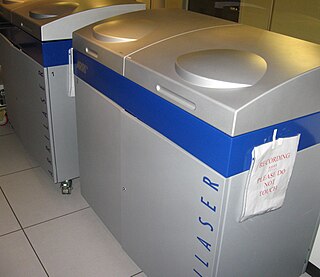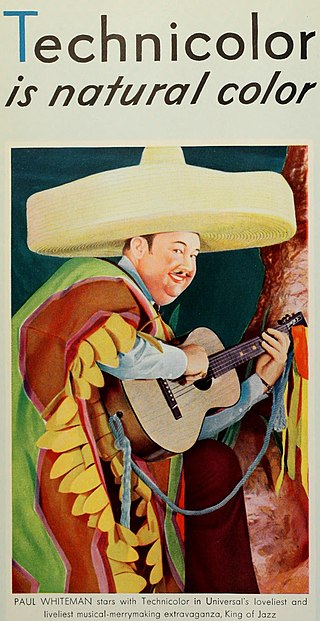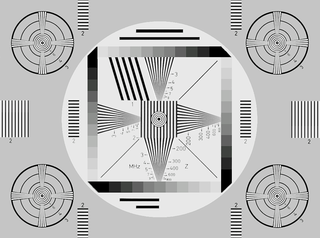
Keykode is an Eastman Kodak Company advancement on edge numbers, which are letters, numbers and symbols placed at regular intervals along the edge of 35 mm and 16 mm film to allow for frame-by-frame specific identification. It was introduced in 1990.

Post-production is part of the process of filmmaking, video production, audio production, and photography. Post-production includes all stages of production occurring after principal photography or recording individual program segments.

Telecine is the process of transferring film into video and is performed in a color suite. The term is also used to refer to the equipment used in this post-production process.
Digital Picture Exchange (DPX) is a common file format for digital intermediate and visual effects work and is a SMPTE standard. The file format is most commonly used to represent the density of each colour channel of a scanned negative film in an uncompressed "logarithmic" image where the gamma of the original camera negative is preserved as taken by a film scanner. For this reason, DPX is the worldwide-chosen format for still frames storage in most digital intermediate post-production facilities and film labs. Other common video formats are supported as well, from video to purely digital ones, making DPX a file format suitable for almost any raster digital imaging applications. DPX provides, in fact, a great deal of flexibility in storing colour information, colour spaces and colour planes for exchange between production facilities. Multiple forms of packing and alignment are possible. The DPX specification allows for a wide variety of metadata to further clarify information stored within each file.
Digital intermediate (DI) is a motion picture finishing process which classically involves digitizing a motion picture and manipulating the color and other image characteristics.

Film preservation, or film restoration, describes a series of ongoing efforts among film historians, archivists, museums, cinematheques, and non-profit organizations to rescue decaying film stock and preserve the images they contain. In the widest sense, preservation assures that a movie will continue to exist in as close to its original form as possible.

A film recorder is a graphical output device for transferring images to photographic film from a digital source. In a typical film recorder, an image is passed from a host computer to a mechanism to expose film through a variety of methods, historically by direct photography of a high-resolution cathode ray tube (CRT) display. The exposed film can then be developed using conventional developing techniques, and displayed with a slide or motion picture projector. The use of film recorders predates the current use of digital projectors, which eliminate the time and cost involved in the intermediate step of transferring computer images to film stock, instead directly displaying the image signal from a computer. Motion picture film scanners are the opposite of film recorders, copying content from film stock to a computer system. Film recorders can be thought of as modern versions of Kinescopes.
The Cineon System was one of the first computer based digital film systems, created by Kodak in the early 1990s. It was an integrated suite of components consisting a Motion picture film scanner, a film recorder and workstation hardware with software for compositing, visual effects, image restoration and color management.

An optical printer is a device consisting of one or more film projectors mechanically linked to a movie camera. It allows filmmakers to re-photograph one or more strips of film. The optical printer is used for making visual effects for motion pictures, or for copying and restoring film material.

A motion picture film scanner is a device used in digital filmmaking to scan original film for storage as high-resolution digital intermediate files.

A flying-spot scanner (FSS) uses a scanning source of a spot of light, such as a high-resolution, high-light-output, low-persistence cathode ray tube (CRT), to scan an image. Usually the image to be scanned is on photographic film, such as motion picture film, or a slide or photographic plate. The output of the scanner is usually a television signal.
Transformers is a franchise centered on shapeshifting alien robots.

A film chain or film island is a television – professional video camera with one or more projectors aligned into the photographic lens of the camera. With two or more projectors a system of front-surface mirrors that can pop-up are used in a multiplexer. These mirrors switch different projectors into the camera lens. The camera could be fed live to air for broadcasting through a vision mixer or recorded to a VTR for post-production or later broadcast. In most TV use this has been replaced by a telecine.
A color suite is the control room for color grading video in a post-production environment.

Spirit DataCine is a telecine and a motion picture film scanner. This device is able to transfer 16mm and 35mm motion picture film to NTSC or PAL television standards or one of many High-definition television standards. With the data transfer option a Spirit DataCine can output DPX data files. The image pick up device is a solid state charge-coupled device. This eliminated the need for glass vacuum tube CRTs used on older telecines. The units can transfer negative film, primetime, intermediate film and print film, stock. One option is a Super 8 gate for the transfer of Super 8 mm film. With a sound pick up option, optical 16mm and 35mm sound can be reproduced, also 16mm magnetic strip sound. The unit can operate stand alone or be controlled by a scene by scene color corrector. Ken Burns created The Civil War, a short documentary film included in the DVD release, on how he used the Spirit DataCine to transfer and remaster this film. The operator of the unit is called a Colorist or Colorist Assistant. The Spirit DataCine has become the standard for high-end real-time film transfer and scanning. Over 370 units are used in post-production facilities around the world. Most current film productions are transferred on Spirit DataCines for Television, Digital television, Cable television, Satellite television, Direct-to-video, DVD, Blu-ray Disc, pay-per-view, In-flight entertainment, Stock footage, Dailies, Film preservation, digital intermediate and digital cinema. The Spirit DataCine is made by DFT Digital Film Technology GmbH in Darmstadt, Germany.

Technicolor is a series of color motion picture processes, the first version dating back to 1916, and followed by improved versions over several decades.
The Pixar Photoscience Division, a division of Pixar Animation Studios, was founded in 1979 at Lucasfilm for the express purpose of designing and building a laser recorder/scanner system to input and output film to a computer for compositing and color correction of special effects. In the early years of Pixar's history, the team was responsible for the design of color monitoring instrumentation to control the color gamut and gamma of the digital images onto 35mm film using a more advance laser recorder system called PixarVision. In later years at Pixar, the team was responsible for transforming the artists computer-animated images onto film master negatives. Today the team manages all digital content to a variety of delivery media, film, DVD, and digital cinema projection. The team has won Engineering and Technical Academy Awards and patents for their work in Motion Picture Sciences.

Test film are rolls or loops or slides of photographic film used for testing the quality of equipment. Equipment to be tested could include: telecine, motion picture film scanner, Movie projectors, Image scanners, film-out gear, Film recorders and Film scanners.










